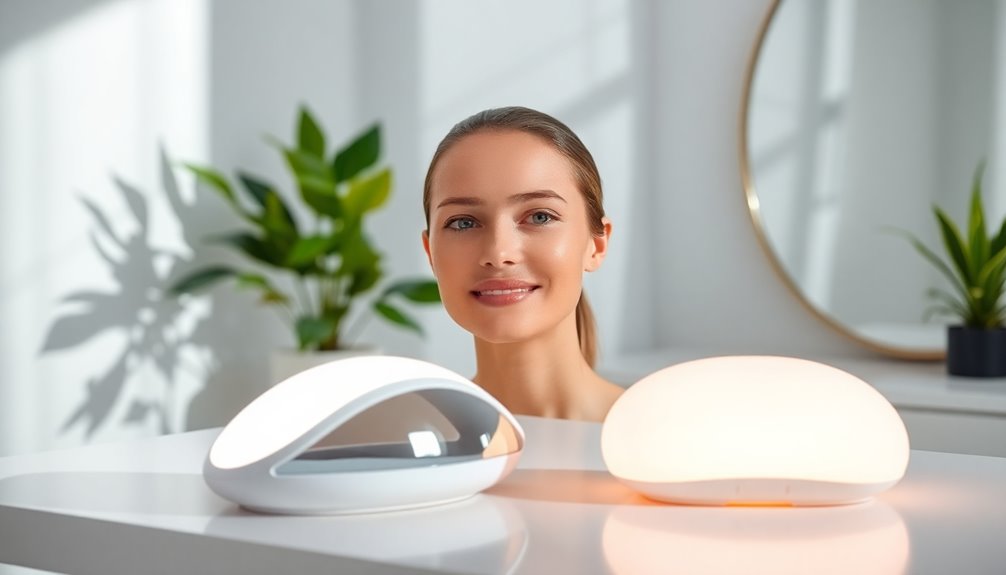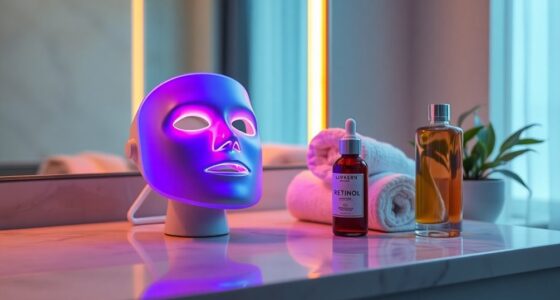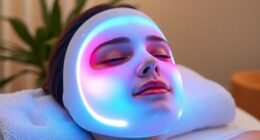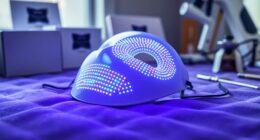After one month of LED therapy, you can expect noticeable changes in your skin. Fine lines and wrinkles may start to diminish, while your skin tone becomes more even. You might also see a reduction in acne and inflammation, thanks to targeted light treatments. As collagen production increases, your skin's texture and elasticity improve, giving you a youthful glow. Some users even report enhanced energy and better sleep quality. For the best results, consistency is key. If you're curious about other benefits and tips for maximizing your LED therapy, keep exploring further to uncover more insights.
Key Takeaways
- After one month of LED therapy, expect a noticeable reduction in fine lines and wrinkles.
- Increased collagen production leads to improved skin texture and a more youthful appearance.
- Dark spots may lighten, resulting in a more even skin tone.
- Enhanced skin elasticity contributes to a softer overall appearance.
- Conditions like acne and rosacea often show decreased inflammation and improved healing.
Visible Changes in Skin
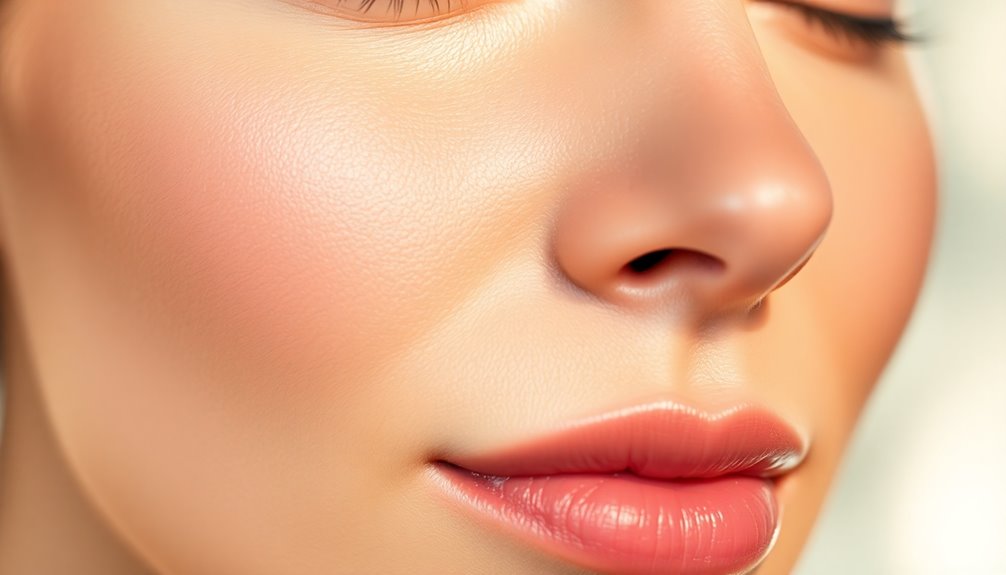
After a month of LED therapy, you might notice some exciting visible changes in your skin. One of the most significant improvements is a reduction in fine lines and wrinkles. The red light stimulates collagen production, enhancing your skin's texture and making it look smoother and more youthful. Additionally, studies show that red-light LED devices can improve fine lines and wrinkles, further validating your positive results. Regular use of glycolic acid products can also complement the effects of LED therapy by aiding in exfoliation and enhancing skin radiance.
You may also see a lightening of dark spots, leading to a more even skin tone. These changes happen because the red light penetrates deeply, promoting cellular processes that reduce melanin.
Furthermore, consistent use can improve your skin's overall texture and elasticity, resulting in a softer, more radiant appearance. Remember, regular treatment is key to maintaining these fantastic results, so keep up with your LED sessions!
Improvement in Skin Conditions
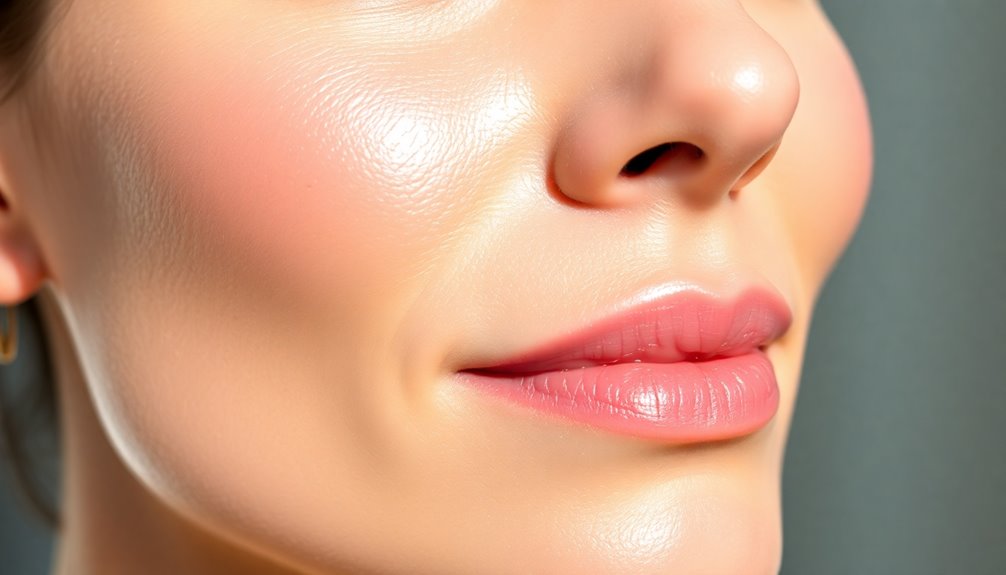
As you continue with LED therapy, you may experience notable improvements in various skin conditions.
For acne, blue light helps reduce oil production and kill bacteria, leading to clearer skin over multiple sessions. You might also notice fewer breakouts and less inflammation.
If you're concerned about aging, red light stimulates collagen production, smoothing wrinkles and fine lines while reducing discoloration. Plus, your skin could feel softer and tighter. Research indicates that multiple treatment sessions are often required for optimal results.
Red and near-infrared light can significantly alleviate psoriasis symptoms by lowering redness and inflammation, making your skin feel more comfortable.
Additionally, if you've had any wounds or skin resurfacing, red light aids in faster healing and reduces swelling.
Recommended Treatment Protocol

A well-structured treatment protocol is essential for maximizing the benefits of LED therapy.
Start with pre-treatment preparation by cleansing your skin twice, exfoliating to clear pores, and applying a light-activated serum. Cleansing skin removes makeup and dirt ensures that your skin is properly prepped for the subsequent treatments.
Don't forget eye protection and a light enzyme mask with steam.
During the LED session, position the device close to your face, ideally for 30 minutes, and utilize various light frequencies.
After treatment, reapply serum, moisturize, and use sunscreen to shield your skin.
For maintenance, schedule follow-up sessions every few months and use your at-home device 2-3 times weekly for optimal results.
Consistency matters, so stick with the routine for the best outcomes.
Remember to follow professional guidelines for specific skin concerns.
Potential Side Effects
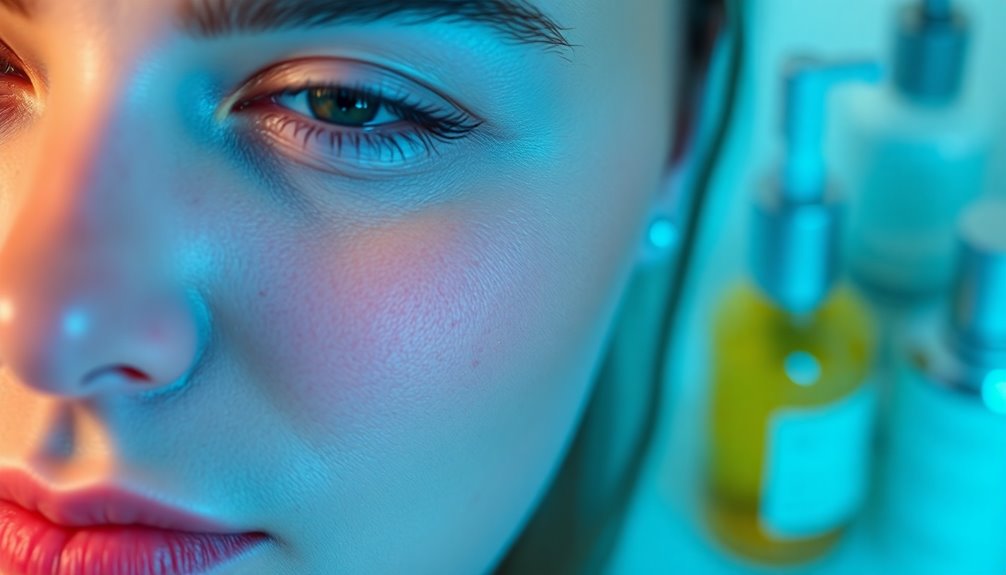
While following the recommended treatment protocol for LED therapy can enhance your skin's health, it's important to be aware of potential side effects that may arise.
You might experience common issues like headaches, eye strain, and mild skin irritation. These can often be mitigated by using proper eyewear and taking breaks as needed. Additionally, if you're undergoing photodynamic light therapy, be cautious, as this treatment may increase your sensitivity to light, leading to more pronounced side effects.
If you're on certain medications, be cautious, as they may increase your sensitivity to light, leading to more pronounced side effects.
Rarely, you could face pain, rashes, or even a severe sunburn-like reaction.
Always consult with your healthcare provider if you have pre-existing conditions or concerns, and start with shorter sessions to gauge your skin's response.
Enhanced Energy and Sleep
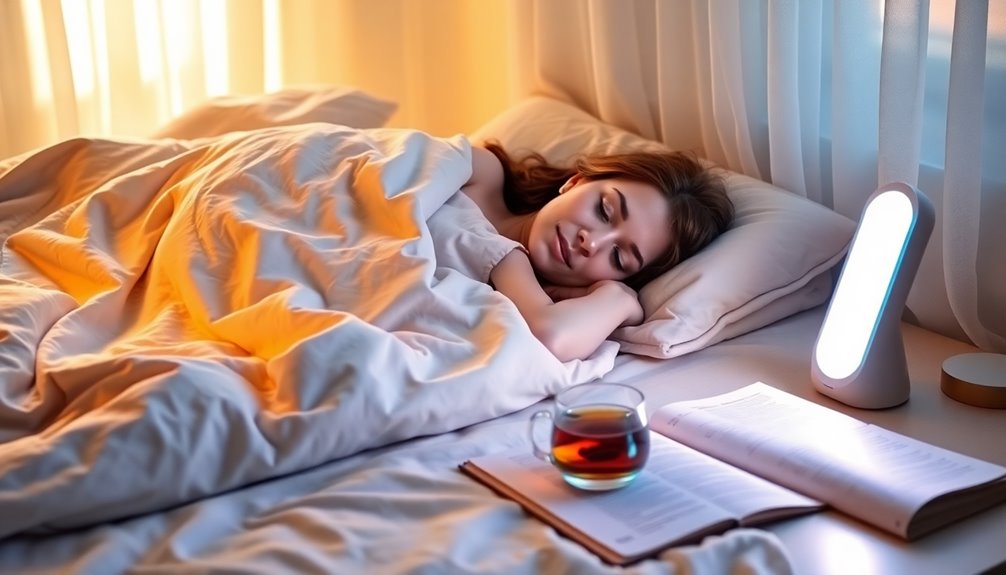
Many people find that incorporating LED therapy into their routine leads to significant improvements in both energy levels and sleep quality. Red light therapy helps reduce inflammation and lower cortisol, boosting serotonin and melatonin production, which enhances your sleep quality. Additionally, it has been shown to aid in pain relief for chronic conditions, allowing for a more restful night's sleep. Regular sessions can supercharge your cells, increasing ATP energy production, so you feel more energized throughout the day. This boost in energy aligns with the abundance mindset, allowing individuals to perceive their energy levels and overall well-being more positively. Meanwhile, 40Hz light therapy synchronizes your brain's natural rhythm, making it easier to fall asleep and stay asleep. Bright light therapy also helps regulate your body clock, improving alertness and reducing fatigue. Together, these therapies create a powerful combo, enhancing not just how well you sleep, but how energized you feel during the day.
Long-Term Benefits

As you continue with LED therapy, you'll likely notice a range of long-term benefits that can significantly enhance your overall well-being.
You'll experience improved skin appearance, including reduced wrinkles and fine lines due to increased collagen production. Your skin texture may feel smoother, and you'll enjoy a more even skin tone with fewer acne breakouts. Additionally, the therapy can also aid in wound healing, further enhancing your skin's resilience.
Additionally, LED therapy stimulates hair follicles, potentially leading to increased hair density and reduced hair loss.
You might also notice reduced inflammation, which can decrease redness and swelling, improving conditions like acne and rosacea.
Treatment Consistency Importance

To achieve the best results from LED therapy, maintaining consistency in your treatment schedule is essential. Regular sessions, ideally 3-5 times a week, help ensure the effectiveness of the therapy. If you miss a session, it could delay noticeable changes, so restart your routine as quickly as possible. Remember, longer sessions don't guarantee better results; sticking to the recommended duration is crucial. The cumulative effect of consistent use leads to gradual improvements in your skin and overall well-being. Integrating therapy into your daily routine can help regulate your mood and energy levels. Additionally, consistent use of red light therapy is known to promote collagen synthesis, further enhancing your skin's appearance. Prioritize your treatment by avoiding unnecessary cancellations, ensuring you stay on track for the best outcomes with LED therapy.
Choosing the Right Device
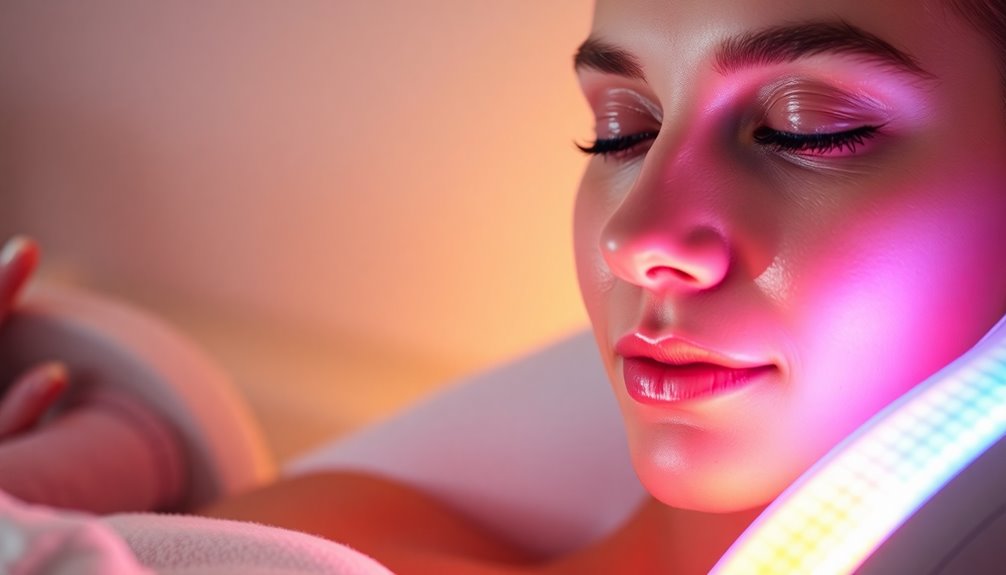
Selecting the right LED therapy device is crucial for maximizing your treatment outcomes. First, consider the wavelengths: red light helps reduce inflammation and boosts collagen, while blue light targets acne bacteria.
If you're looking for general skin rejuvenation, yellow and amber lights are effective. Portability is another factor; handheld devices like the LumaGlow are compact and perfect for on-the-go use. Additionally, understanding the different wavelengths available can help you tailor your treatment to specific skin concerns.
Evaluate comfort too—opt for ergonomic designs with adjustable settings. Lastly, think about session length and frequency; at-home devices often require longer sessions. Regular use, sometimes twice a day, may be necessary to maintain results.
Frequently Asked Questions
Can LED Therapy Be Used During Pregnancy?
Yes, you can use LED therapy during pregnancy, but it's essential to proceed with caution.
Consult your healthcare provider first to ensure it's suitable for your specific situation. Generally, LED therapy is non-invasive and poses minimal risk when used responsibly.
Start with short sessions and monitor your body's response, avoiding direct application to your abdomen, especially later in pregnancy.
Prioritize your overall well-being by combining therapy with proper prenatal care.
How Soon Can I Expect Results After Starting Treatment?
Did you know that 70% of users report noticeable skin improvements within just two weeks of starting LED therapy?
You can expect some immediate effects, like relaxation and improved mood, right after your first session.
However, visible changes in skin tone or reduced inflammation typically take one to two weeks with consistent treatment.
Everyone's response varies, so stick to a regular schedule for the best results over time!
Is LED Therapy Safe for All Skin Types?
Yes, LED therapy's safe for all skin types.
It doesn't emit harmful UV rays and is non-invasive, so you won't experience burns or downtime.
With FDA-cleared devices, you can trust its safety and efficacy.
Just remember to protect your eyes during treatment.
If you have sensitive skin or specific conditions, consult a dermatologist for tailored options.
Rare side effects may occur, but they're generally mild and temporary.
Enjoy the benefits without worry!
Can I Combine LED Therapy With Other Skincare Treatments?
Did you know that 80% of people see improved skin texture when combining LED therapy with other treatments?
You definitely can combine LED therapy with various skincare options like chemical peels or microneedling. This synergy boosts collagen production and enhances results.
Just remember to consult a professional for personalized guidance, and be mindful of your skin's sensitivity.
Together, these treatments can create a comprehensive approach to achieving your best skin yet.
What Should I Do if I Experience Skin Irritation?
If you experience skin irritation from LED therapy, don't panic.
Start by reducing the duration and frequency of your sessions to see if that helps. Apply a gentle moisturizer to soothe your skin and avoid harsh products.
Monitor your skin's reaction closely. If irritation persists, consider consulting a dermatologist for tailored advice.
Conclusion
After a month of LED therapy, you’re likely to notice some significant skin shifts and soothing sensations. Staying consistent with your sessions can lead to lasting benefits, from clearer complexions to enhanced energy levels. Don’t forget to choose the right device that fits your needs, ensuring you get the most from this transformative treatment. Embrace the journey and enjoy the glow, as your skin shines with renewed radiance and resilience! As you marvel at the improvements, you might find yourself wondering how long for LED therapy results to become fully apparent. Typically, noticeable changes may take a few weeks, but individual experiences can vary based on skin type and concerns. Keep in mind that patience is key; sustained results often emerge from ongoing commitment to your routine and healthy lifestyle choices.
